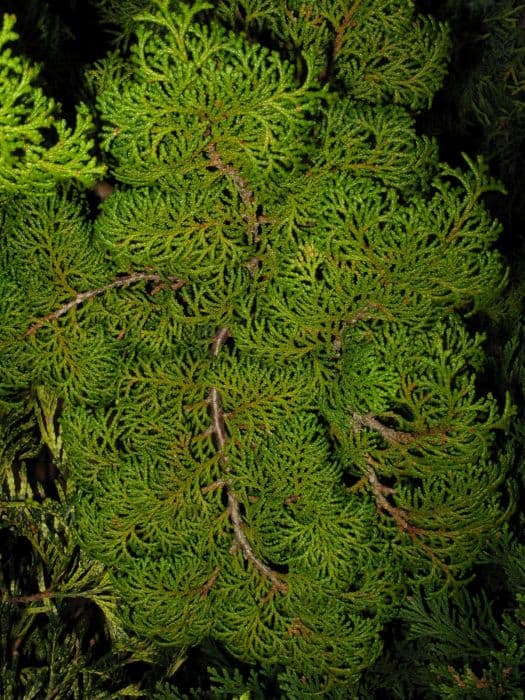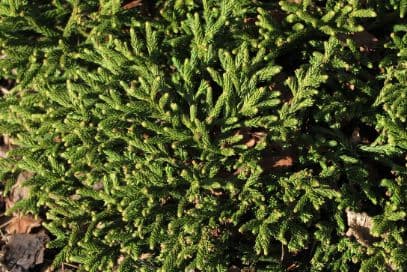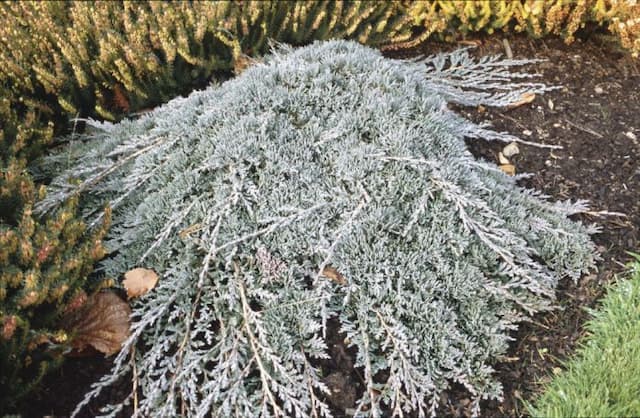American arborvitae Thuja occidentalis 'Danica'

ABOUT
The Thuja occidentalis 'Danica', commonly known as the American Arborvitae, is a compact evergreen with a rich green color that retains its hue throughout the year. It has a uniquely globe-shaped formation and boasts dense foliage that radiates from the center of the plant in all directions. The needles of the American Arborvitae are soft to the touch and small when compared to other conifer species, which adds to its decorative appeal. The leaves are arranged in a flattened, scale-like pattern that overlaps in a shingle-like fashion, giving it a textured look and feel. This cultivar presents a tidy and well-groomed appearance without the need for regular pruning, making it a popular choice for both formal and informal landscape settings. The American Arborvitae 'Danica' exudes a fresh, wooden scent, and during certain times of the year, it may bear small, inconspicuous cones that blend seamlessly into the foliage. Overall, its lush and rounded silhouette makes it an attractive ornamental plant for a variety of garden styles.
About this plant
 Names
NamesFamily
Cupressaceae
Synonyms
Danica Eastern Arborvitae, Danica Arborvitae, Globe Arborvitae, Dwarf Globe Arborvitae, Danica White Cedar
Common names
Thuja occidentalis 'Danica'
 Characteristics
CharacteristicsLife cycle
Perennials
Foliage type
Evergreen
Color of leaves
Green
Height
2 feet (0.61 meters)
Spread
2 feet (0.61 meters)
Plant type
Shrub
Hardiness zones
3
Native area
North America
Benefits
 General Benefits
General Benefits- Low Maintenance: Eastern Arborvitae 'Danica' is known for requiring minimal upkeep, making it ideal for gardeners of all experience levels.
- Evergreen Foliage: Retains its green color year-round, providing constant visual interest in the landscape.
- Compact Size: Its small, globular form fits well in limited spaces and is suitable for container gardening.
- Winter Interest: Maintains structure and color even in the colder months, adding life to a dormant garden.
- Wildlife Habitat: Offers shelter and nesting sites for birds and other wildlife.
- Drought Tolerance: Once established, it is relatively tolerant of dry conditions, reducing the need for frequent watering.
- Decorative: The dense foliage and unique spherical shape make it an attractive choice for ornamental use.
 Medical Properties
Medical Properties- Aromatherapy: Essential oil from Thuja occidentalis, also known as northern white cedar, can be used in aromatherapy for relaxation and stress relief, but must be used with caution due to potential toxicity.
- Homeopathic Remedies: Homeopathically, Thuja is used for certain skin conditions, such as warts or polyps, under the guidance of a qualified homeopathic practitioner.
- Traditional Medicine: Historically in traditional medicine, Thuja has been used for respiratory tract infections, but its effectiveness and safety are not scientifically validated.
 Air-purifying Qualities
Air-purifying QualitiesThis plant is not specifically known for air purifying qualities.
 Other Uses
Other Uses- Thuja occidentalis 'Danica', commonly known as American arborvitae, can be used in model making or dioramas as miniature trees due to its dense, compact growth habit.
- The wood of American arborvitae is naturally resistant to decay and can be used for creating small outdoor garden structures like trellises or plant supports.
- Because of its pleasant scent, the foliage can be used in potpourris or as a natural air freshener within confined spaces such as wardrobes or drawers.
- The dense foliage is often used as a nesting site for small birds, providing shelter and protection for avian wildlife in gardens.
- American arborvitae can be used in bonsai culture, where it is valued for its ability to adapt to pruning and shaping into miniature tree forms.
- The soothing color and texture of the plant can be utilized in therapeutic gardens designed to promote relaxation and reduce stress.
- Its dense habit and evergreen nature make American arborvitae suitable as a privacy screen or living fence in urban settings.
- During winter, the evergreen foliage provides a contrast to snowy landscapes, making it valuable for maintaining winter interest in gardens.
- The wood from American arborvitae can be carved into small decorative items or crafts due to its fine grain and workability.
- In landscape design, American arborvitae can play a role in emphasizing vertical elements or creating symmetry due to its upright growth habit.
Interesting Facts
 Feng Shui
Feng ShuiThe plant_name is not used in Feng Shui practice.
 Zodiac Sign Compitability
Zodiac Sign CompitabilityThe plant_name is not used in astrology practice.
 Plant Symbolism
Plant Symbolism- Protection: Thuja, commonly known as Arborvitae, has been historically used to create hedges and barriers; thus, it symbolizes protection and privacy.
- Longevity and Immortality: Arborvitae can live for a very long time, with some species living for more than a thousand years. Therefore, it represents longevity and immortality.
- Evergreen: Being an evergreen plant, Arborvitae symbolizes eternal life and resilience as it keeps its foliage throughout the year regardless of the seasons.
- Healing: Arborvitae has been used in traditional medicine for its purported healing properties, symbolizing health and healing.
 Water
WaterArborvitae 'Danica' should be watered deeply and thoroughly to ensure the root ball is moistened. In the first growing season, water the plant once or twice a week depending on the weather conditions, more frequently during hot and dry spells. Once established, the plant is somewhat drought-tolerant but will benefit from watering every two to three weeks, with more frequent watering required in extreme heat. Provide about 1-2 gallons of water per week during the first year, and adjust as necessary as the plant gets established. Avoid overwatering as it can lead to root rot.
 Light
LightArborvitae 'Danica' thrives best in full sun to partial shade. It should be planted in an area where it will receive at least four to six hours of direct sunlight each day. While it can tolerate shade, too much shade can lead to sparse foliage and a less robust plant. Choose a spot without heavy shade to encourage dense and healthy growth.
 Temperature
TemperatureArborvitae 'Danica' is hardy and can tolerate a wide range of temperatures. It grows best in temperatures between 40 to 75 degrees Fahrenheit but can survive temperatures as low as -40 degrees and as high as 80 degrees Fahrenheit. To ensure the best growth and health, avoiding extreme temperature fluctuations is important.
 Pruning
PruningArborvitae 'Danica' requires minimal pruning, primarily to shape the plant or remove any damaged or diseased branches. The best time for pruning is in the early spring before new growth begins, or in the late spring after the new growth has hardened off. Annual light pruning helps maintain its globe-like shape and encourages lush, healthy foliage.
 Cleaning
CleaningNot needed
 Soil
SoilThe American Arborvitae 'Danica' (Thuja occidentalis 'Danica') thrives best in moist, well-drained soil with a slightly acidic to neutral pH, ideally between 6.0 and 8.0. A good soil mix may include garden soil, compost, and peat moss to ensure adequate drainage and fertility.
 Repotting
RepottingAmerican Arborvitae 'Danica' does not require frequent repotting and can go several years without being disturbed due to its slow growth rate. It is typically repotted only when it outgrows its current container or when the soil quality degrades.
 Humidity & Misting
Humidity & MistingAmerican Arborvitae 'Danica' is quite adaptable and can tolerate a wide range of humidity levels, but it performs best in moderate to high humidity conditions. It is resilient and does not require specific humidity adjustments when grown outdoors.
 Suitable locations
Suitable locationsIndoor
Place 'Danica' in bright light, avoid dry air and water soil regularly.
Outdoor
Plant 'Danica' in full sun to partial shade, and in well-drained soil.
Hardiness zone
2-7 USDA
 Life cycle
Life cycleThe life cycle of Thuja occidentalis 'Danica', commonly known as American arborvitae 'Danica', begins with seed germination, where the seeds require a period of cold stratification to break dormancy. Once germinated, the seedlings establish themselves and enter a juvenile vegetative phase, growing into small bushes with their characteristic evergreen, scale-like leaves. As they mature, these shrubs enter a reproductive phase, developing small cones that carry their seeds—pollination is typically by wind, with male and female cones often on the same plant. After reaching maturity, these shrubs can reproduce annually, with cones maturing in one year and releasing seeds in late summer or fall. The lifecycle stages repeat annually, with these shrubs having the potential for long lifespans, often living several decades if conditions are favorable. Over time, they may reach a senescence phase, where growth slows and they become less vigorous, ultimately leading to the end of the plant’s life cycle.
 Propogation
PropogationPropogation time
Spring-Early Summer
The most common method of propagating Thuja occidentalis 'Danica', commonly known as American arborvitae 'Danica', is through semi-hardwood cuttings. This is typically done in late summer. You would take cuttings of the plant's current year growth, making sure they are about 4 to 6 inches (approximately 10 to 15 centimeters) long. The bottom inch of the cutting should be stripped of needles, and the cut end can be dipped in a rooting hormone to encourage root development. Then, the prepared cutting is placed in a well-draining rooting medium, such as a mix of peat and perlite, and kept in a humid, shaded area until roots have developed, which usually takes several weeks. It is important to maintain consistent moisture during the rooting process but avoid waterlogging the medium.









